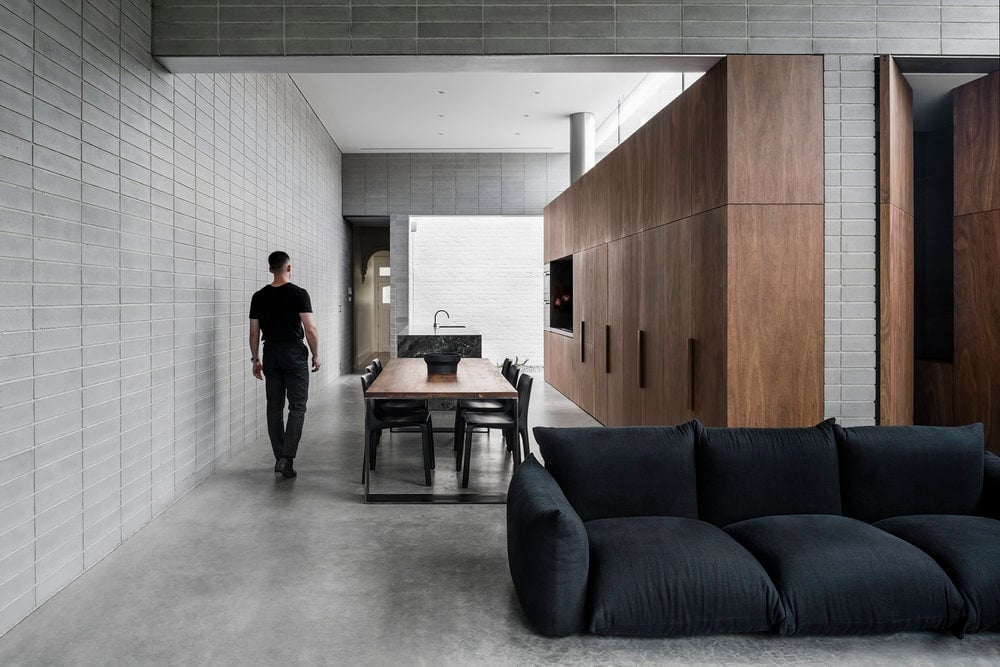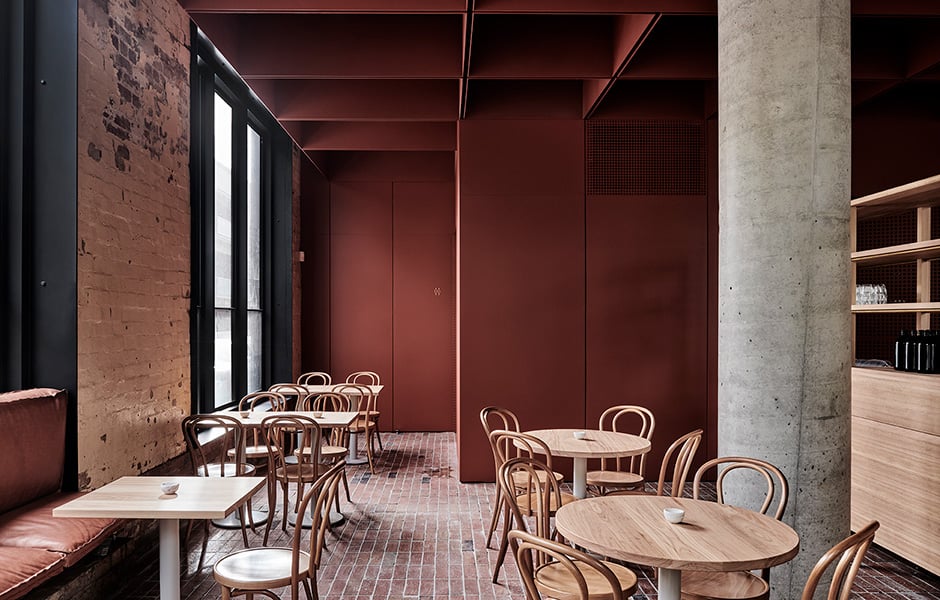
In our ongoing series featuring new and inspiring design practices, more space caught up with architect Gilad Ritz and interior architect Jean-Paul Ghougassian who co-founded Ritz & Ghougassian just over two years ago. Since then, the studio has been busy building a folio of finely honed interiors that has won them a prestigious AIDA Emerging Interior Design Practice accolade and a loyal following.
Ritz & Ghougassian is a fresh new Melbourne design studio. After meeting through friends and working together on a project first, Gilad and Jean-Paul quickly found their design approach was in tune and a few months later the partnership was a reality. "We worked well together which is an important thing", remarks Gilad. "We have two different approaches but the same objective".
Described by the AIDA jury as "refined, architecturally rigorous and notable for its strong adherence to a set of shared design values", when you look at their body of work to date – a mix of retail spaces, homes and multi-residential projects – it is the colour, detail and materiality that grabs attention. Interiors are layered with texture and an astute eye for colour provides continuity and richness to each project.
In the following interview with more space, Gilad and Jean-Paul discuss the way the studio works, the benefits of winning awards beyond the accolades, good collaboration, material experimentation and fine-tuning ideas, and the coffee machine that was their first big investment – and took up the lion's share of the studio.

The Highbury Grove House (here and above) by Ritz & Ghougassian was awarded a Commendation at the Australian Interior Design Awards, the design practice described by the jury as, "refined, architecturally rigorous and notable for its strong adherence to a set of shared design values", Photo Tom Blachford.
more space: How would you describe the architecture that you do?
Gilad: We are very interior focused. Each project is a series of moments always looking for opportunities to bring the external environment in. A view becomes part of the interior experience and is unique to that space so we use architecture as a medium to relate to the external environment.
Jean-Paul: I think to put it succinctly, we want people to have a visceral experience, to touch people in a way that you wouldn’t get through viewing a photo.
Are there particular architects who have influenced your paths?
Gilad: There is a bit of overlap. We both appreciate Tadao Ando, John Pawson and Shigeru Ban. From a more theoretical perspective, there are references that I also draw from. Ideas in the book 'Poetic Space' by Gaston Bachelard and the essays by the architect Arata Isozak about space and time. It is exciting to see how they translate into our work. When we presented our Highbury Grove House to the Institute of Architects Awards jury recently, I went back to refresh my theoretical practice. Instead of thinking intuitively, I had to explain it.
So beyond the accolades, do you think there is another important aspect to design competitions?
Gilad: Yes, they force you to sharpen your presentation skills and your theoretical knowledge. Competitions are character builders. Across your projects, the application of materials has a depth and maturity.
Could you describe the material approach to the recently completed Bentwood café and Highbury Grove House?
Jean-Paul: We look at materials with a singular approach of tonality, and then overlay that with texture. Bentwood is a very good example of that. There are a lot of materials but in terms of colour, it is very singular.
Gilad: Our use of concrete blockwork at Highbury Grove comes down to the studio's theoretical approach to materiality. It had to be the same material on the outside and the inside because we don’t want to delineate between the interior and the exterior. It is more about creating spaces that are loosely defined. We also use Australian timbers because we like the way that eucalyptus grows and creates a fiddle back effect, the swirls of woodgrain contrasts nicely.
Jean-Paul: We like the idea of bringing context to every part of a project. It is one way to differentiate ourselves. It comes back to the fact that we don’t do faddish work. If we are using stone, we want to try to find an Australian stone, as well as local leathers and materials right down to the furniture.
Gilad: There are probably only a handful of furniture pieces that we like and given the chance, we end up using them on every job.
I noticed you have included the classic 1970s Arflex Marenco sofa at Highbury Grove, it’s a design that Tadao Ando likes to use in his projects too.
Gilad: Yes it is really nice. It sits, in contrast, to the harshness of the concrete blockwork.
The Bentwood café also has a strong connection with the area’s built heritage, what is the story there?
Gilad: It is located inside an existing building with a heritage wall that is part of an apartment complex in Fitzroy, an area of Melbourne that features a lot of red pressed brick. We specified the same red brick paver as the apartment laneway to reference the local area, and when we realised that all structural steel is painted in red oxide, we thought that was perfect for the interior. It stops the steel from rusting so it serves a purpose, it is not only about colour. We ended up painting all the steelwork in red oxide which marries perfectly with the red bricks and heritage wall. Then elements of skeletal timber divide up the interior into a series of moments.

The Bentwood café in Fitzroy, Melbourne, tunes into the neighbourhood's local material palette and frames views. Photo Tom Blachford.
"Moments experimenting with materials are exciting. Every detail becomes an avenue to do something new."
Gilad Ritz, Ritz & Ghougassian
There is a confidence in your palette selection and a freshness in the details that you develop. How do you approach each project?
Jean-Paul: I don’t think we try and reinvent the wheel every time. It’s about finessing. Like a sushi chef, honing in on the skills and the experiences you have had before and trying to Improve them over time.
Gilad: Moments experimenting with materials are exciting. Every detail becomes an avenue to do something new. Site restrictions and budget are almost always the catalysts for experimenting with new materials, for example, we started off working with concrete blockwork because we were doing projects in tight little laneways in Prahran in Melbourne where the site access isn’t great. Blockwork is also a nice alternative to doing in-situ concrete which is incredibly expensive.
"There is an underlying approach to every project that we do so I don’t think we try and reinvent the wheel every time. It’s about finessing. Like a sushi chef, honing in on the skills and the experiences you have had before and trying to Improve them over time."
Jean-Paul Ghougassian, Ritz & Ghougassian
A close collaboration with craftspeople and trades is evident in the beautifully detailed interiors that celebrate materials. How important are those relationships in the development of your design practice?
Jean-Paul: They are paramount and intrinsic to the work we do. If we are doing an architectural job we will be down on site three times a week really working with those craftsmen to try and make sure that everything is considered. As a young studio, I think you rely on your trades for their experience. It is really about working with someone from the very beginning and making sure all of your ducks are aligned before you get on site. We have a pretty lengthy collaboration period before we actually do anything on site.
Gilad: We like to work with trades and suppliers who are patient. There is always a solution to a problem and what we have come to know is there is always a few ways to work it out. Often it's a matter of working through issues together and not being too dogmatic in your approach.
Jean-Paul: I think if we are talking about collaborators obviously the client is our most important collaborator and we have got a couple of key clients who we work with closely. It is about having mutual respect and trust for one another. A good client will have a shared vision and trust that you are going to produce something that is worthy of what they are trying to achieve. From a commercial point of view, we have one client in particular who has been really open and willing to move forward on every single thing we have proposed which has been a nice change of pace to the typical client.
What is one thing that you haven’t ever designed but would love to?
Gilad: I would love to design a church or a synagogue. I think there are a beautiful solitude and self-reflection in those spaces.
Jean-Paul: Arts or cultural centre. We haven’t had the opportunity to create public spaces outside hospitality which by its nature is very functionally driven, the constraints of amenity can impact the experience of the space.
In many ways, art galleries and places of worship feel related...
Gilad: I think there is definitely a correlation between the two, Mark Rothko’s work, for example, is all about that.
What is currently on the drawing board?
Jean-Paul: We usually have five to eight projects running at any one time, at various stages. Right now we are working on a few smaller multi-residential feasibilities, and a few homes and apartments.
Gilad: Fingers crossed we have also just landed a hotel project in St Kilda.
Thank you Gilad and Jean-Paul.
Ritz & Ghougassian won the Emerging Interior Design Practice Award and a Commendation in the Residential Design category for the Highbury Grove House at the 2018 Australian Interior Design Awards (AIDA). The AIDA program is supported by Space – Australia.


